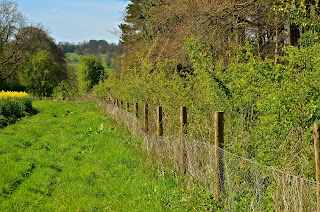 |
| Small Tortoiseshell, where have the large ones gone! |
Wednesday session with NT was cancelled but on Thursday I did help carry out Sherborne's first ukbms butterfly survey, led by Anna {newly appointed environment ranger for Sherborne}, on a
Transect {divided into 5 sections, section 1 Budge Hill Belt to section 5 Windrush camp} in the Budge Hill area. Weather was favourable but it was clearly too early in the season for any significant butterfly numbers to be seen. As it turns out we spotted in section 2 a Small
Tortoiseshell and two Peacocks in section 5, but no '
Dukes'!. That was it for this survey, apart from an appearance of a fine looking
hare in section 5. and ~6 roe deer in section 1.
 |
| Original Revetment work on Sherborne brook, 2013 |
 |
| Mike's tractor trailer full of fascines & stakes, all used! |
 |
| River risen higher than original fascines |
 |
| Some serious repairs and re-tying of fascines |
 |
| One of the new compartments taking shape on 'land' side of new bank |
Todays session with The Wildlife Trust, ironically was at Sherborne, down in the water meadows by Sherborne Brook. The task led by John, with Alan and George assisting, was to carry out some repairs and to add additional 'compartments' to the river bank work previously completed on a stretch of the Sherborne Brook. Already the existing river work can be seen to be doing its job nicely with river depth and flow increased {which should please the fishing fraternity}. The increase in depth meant that additional fascines needed adding to increase height of artificial bank and repairs to some existing fascines needed by adding and/or re-tying. I joined one of the teams in creating the new compartments which were to be constructed on the 'land side' of the new bank to stimulate new plant growth and speed up the process of establishing the new river bank. In the fairly warm conditions it was good to be working in the cool water, provided the waders remained watertight and you didn't swallow any of the water. In addition a water vole survey was carried out and provided good evidence that the habitat improvements in this area is helping to increase vole numbers.
Some more detail from NT director Simon Pryor on a
better environment, hope to see this for real in my patch!

















































